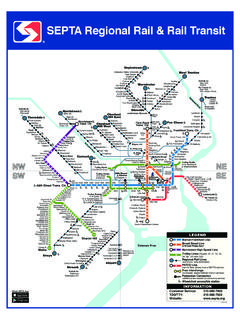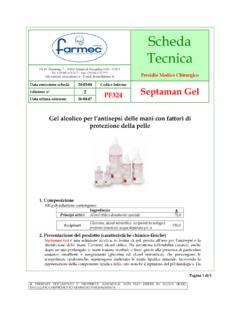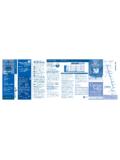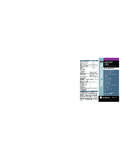Transcription of SEPTANEST Articaine hydrochloride 4% with …
1 SEPTANEST . Articaine hydrochloride 4% with adrenaline 1:100,000. Injection for local and regional dental anaesthesia DESCRIPTION. SEPTANEST is a sterile aqueous solution that contains Articaine hydrochloride 4% (40 mg/mL). with adrenaline acid tartrate in a 1:100,000 strength. Articaine hydrochloride CAS [23964-57-0] MW: ( )-4-methyl-3-[2-(propylamino)-propionami do]-2-thiophene-carboxylic acid, methyl ester hydrochloride . White to almost white powder, odourless. Articaine hydrochloride is a local anaesthetic and is a racemic mixture. Articaine hydrochloride has a partition coefficient in n-octanol/ Soerensen buffer (pH : ) of 17 and a pKa of Adrenaline acid tartrate CAS[51-42-3] MW: ( R )-1-(3,4-di-hydroxyphenyl)-2-methylamino -ethanol hydrogen tartrate C9H13NO3.
2 C4H6O6. White or greyish-white or light brownish grey, odourless, crystalline powder, which slowly darkens on exposure to air and light. Adrenaline acid tartrate mg is approximately equivalent to 1 mg of adrenaline. Adrenaline acid tartrate is a vasoconstrictor. Qualitative and Quantitative Composition Per mL Per mL. cartridge cartridge SEPTANEST 1:100,000. Articaine hydrochloride (INN) mg mg Adrenaline (as acid tartrate) g g Other ingredients Sodium chloride mg mg Sodium metabisulfite mg mg Sodium hydroxide solution (to adjust pH). Water for injection ad mL mL. For single patient use only. Contains no antimicrobial agent. Discard unused contents after use.
3 CLINICAL PHARMACOLOGY. Pharmacodynamics Articaine is a local anaesthetic of the amide type. Preclinical pharmacodynamic studies show that the mechanism of action of Articaine is similar to that of other commonly used anaesthetics (lidocaine, procaine, prilocaine). Inhibition of the generation and the conduction of the action potential but no change in resting potential is shown. Articaine blocks sodium channels and, with lower sensitivity, potassium channels at neutral pH. Inhibition of muscle activation after nerve stimulation and depression of cardiac electrophysiologic measurements demonstrate that Articaine has the same pharmacologic activities as other local anaesthetics.
4 When injected close to sensitive nerve filaments, Articaine has the reversible effect of blocking the conduction of painful sensations. Adrenaline added to the solution reduces bleeding during surgery, slows down the passage of Articaine into the general circulation and thus ensures the prolonged maintenance of an active tissue concentration. Adrenaline acts on both adrenergic receptors of tissue innervated by sympathetic nerves, except for the sweat glands and arteries of the face. It is the most important alpha receptor activator. Adrenaline stimulates the heart to increase output, raises the systolic blood pressure, lowers the diastolic blood pressure, relaxes bronchial spasm and mobilises liver glycogen, resulting in hyperglycaemia and possibly glycosuria.
5 The mean time to onset of anaesthesia after administration of Articaine 4% with adrenaline 1:100,000 is about minutes with a range of 1 to 6 minutes, and the mean duration of anaesthesia is about 68 minutes with a range of 20 to 175 minutes. The pulpal analgesia lasts 75 minutes and the bleeding during surgery is significantly reduced. PHARMACOKINETICS. Absorption: Following dental injection by the submucosal route of a 4% Articaine solution containing 1:200,000. adrenaline, Articaine reaches peak blood concentration about 25 minutes after a single dose injection and 48 minutes after three doses. Peak plasma levels of Articaine achieved after 68 minutes and 204.
6 Mg doses are 385 and 900 ng/mL, respectively. Distribution: Approximately 60 to 80 % of Articaine hydrochloride is bound to human serum albumin and - globulins at 37 C in vitro. Metabolism: Articaine HCl is rapidly metabolized by plasma carboxyesterase to its primary metabolite, articainic acid which is inactive. Articainic acid concentration reaches its peak about 30 to 60 minutes following the peak in Articaine concentration. In vitro studies show that the human liver microsome P450 isoenzyme system metabolises approximately 5% to 10% of the available Articaine with nearly quantitative conversion to articainic acid. Excretion: The elimination half-life of Articaine is about hours and that of articainic acid is about hours.
7 Articaine is excreted primarily through urine with 53 - 57% of the administered dose eliminated in the first 24 hours following submucosal administration. Articainic acid is the primary metabolite in urine. A minor metabolite, articainic acid glucuronide, is also excreted in urine. Articaine constitutes only 2% of the total dose in excreted urine. Special Populations Effect of Age : No pharmacokinetic data is available in the following populations: elderly, children. Race : No pharmacokinetic data is available for different racial groups. Renal and Hepatic Insufficiency : No pharmacokinetic data is available for patients with hepatic or renal impairment.
8 CLINICAL TRIALS. Three randomized, double-blind, active-controlled studies were designed to evaluate effectiveness of SEPTANEST 1:100,000 as a dental anaesthetic. A total of 882 patients received SEPTANEST 1:100,000. Of these, 7% were between 4 and 16 years old, 87% were between 17 and 65 years old, and 6%. were at least 65 years old. In addition, 53% of patients were female and 47% were male, with a racial/ethnic distribution of 73% white, 11% Hispanic, 8% black, 5% Asian and 3% other'. races/ethnicities. These patients underwent simple dental procedures, single apical resections and single crown procedures, and complex dental procedures such as multiple extractions, multiple crowns and/or bridge procedures, multiple apical resections, alveolectomies, muco-gingival operations, and other surgical procedures on the bone.
9 SEPTANEST 1:100,000 was administered as submucosal infiltration and/or nerve block. Efficacy was measured immediately following the procedure by having the patient and investigator rate the patient's procedural pain using a 10 cm visual analog scale (VAS), in which a score of zero represented no pain, and a score of 10. represented the worst pain imaginable. Mean patient and investigator VAS pain scores were - cm for simple procedures and - cm for complex procedures. These values are summarized in Table 1 below. Table 1. Summary of VAS Pain Scores. SEPTANEST 1:100,000. ( Articaine HCl 4% with adrenaline acid tartrate 1:100,000). Simple procedures Complex procedures Number of patients 674 207.
10 Investigator score (cm). Mean Median Range 0 0 Patient score (cm). Mean Median Range 0 0 In clinical trials, 61 pediatric patients between the ages of 4 and 16 years received SEPTANEST 1:100,000. Among these pediatric patients, doses from mg/kg to mg/kg ( to mL). were administered safely to 51 patients for simple procedures and doses between mg/kg and mg/kg ( to mL) were administered safely to 10 patients for complex procedures. However, there was insufficient exposure to SEPTANEST 1:100,000 at doses greater than mg/kg in order to assess its safety in pediatric patients. No unusual adverse events were noted in these patients. Approximately 13% of these pediatric patients required additional injections of anaesthetic for complete anaesthesia.













